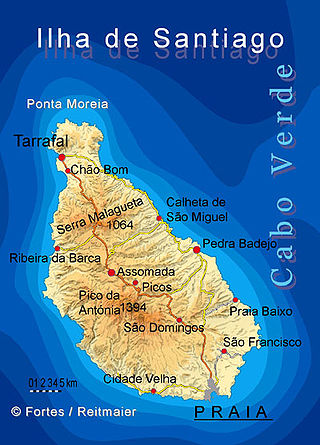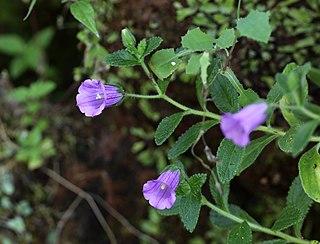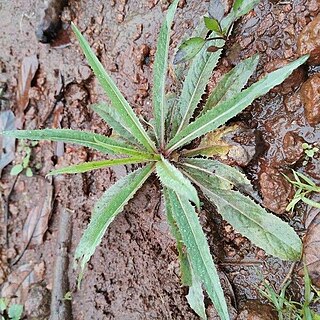
Cape Verde is a group of arid Atlantic islands which are home to distinct communities of plants, birds, and reptiles. The islands constitute the unique Cape Verde Islands dry forests ecoregion, according to the World Wildlife Fund.

Boa Vista, also written as Boavista, is a desert-like island that belongs to the Cape Verde Islands. At 631.1 km2 (243.7 sq mi), it is the third largest island of the Cape Verde archipelago.

Santiago is the largest island of Cape Verde, its most important agricultural centre and home to half the nation's population. Part of the Sotavento Islands, it lies between the islands of Maio and Fogo. It was the first of the islands to be settled: the town of Ribeira Grande was founded in 1462. Santiago is home to the nation's capital city of Praia.

The Cape Verde Islands dry forests is a tropical and subtropical dry broadleaf forests ecoregion in the Cape Verde Islands, which constitute the country of Cabo Verde. The islands lie off the western coast of Africa.

The Canal de São Vicente is a strait of the Atlantic Ocean separating the islands of Santo Antão and São Vicente, Cape Verde. At its narrowest point, it is 11 km (7 mi) wide. The ferry route between the ports of Porto Novo on Santo Antão and Mindelo on São Vicente crosses the canal. The channel begins in São Vicente's northwesternmost cape near Monte Cara up to the headland Ponta de João d'Évora in the northeast.

The wildlife of Cape Verde is found across its archipelago of ten islands and three islets, albeit in smaller numbers of species than mainland Africa. Each volcanic island within the archipelago is unique, and each of them have parks under their jurisdiction, by decree promulgated by the Cape Verde government. Located just off the west coast of Africa, the total land area of the island nation is 4,564 square kilometres (1,762 sq mi).
With the exception of bats, there are no truly endemic species of mammal on Cabo Verde; historically, the archipelago was only accessible to creatures with the ability to fly or swim, or to be brought by humans. The islands were first explored in 1456, but not actually settled until 1462; humans brought their livestock with them, including donkeys, pigs, cattle and goats—many of the latter are now so wild, they resemble mainland ibex, and are considered endemic “by default”.
In the centuries since settlement began, more mainland species would make their way with waves of settlers. There are no snakes present on the archipelago, which has allowed for the proliferation of many other species of other herpetiles, such as geckos, frogs and lizards. The main predators of these reptiles and amphibians would be the various birds of prey and raptors present, including the Egyptian vulture, Eurasian buzzard, kestrel, osprey, peregrine falcon, and the rare Cape Verde kite. This kite species is currently threatened by extinction but may yet be observed on Boa Vista and Maio.

Sideroxylon mirmulano, commonly known as marmulano, is a species of flowering plants in the family Sapotaceae. It is endemic to the Madeira Islands (Portugal). It is threatened by habitat loss.

Campanula jacobaea is a species of flowering plants of the Campanulaceae family. The species is endemic to Cape Verde and is listed as vulnerable by the IUCN. Its local name is contra-bruxas-azul. The plant is used in traditional medicine. Campanula jacobaea is shown on a Cape Verdean $5 escudo coin issued in 1994.
Limonium jovibarba is a species of flowering plants of the family Plumbaginaceae. The species is endemic to Cape Verde. It is listed as critically endangered by the IUCN. The species was named by Carl Ernst Otto Kunze in 1891. Its local name is carqueja, a name that may also refer to the related species Limonium brunneri and Limonium braunii.
Sonchus daltonii is a species of flowering plants of the family Asteraceae. The species is endemic to Cape Verde. It is listed as endangered by the IUCN. The genus was named by Philip Barker Webb in 1849. Its local name is coroa-de-rei.
Limonium brunneri is a species of flowering plants of the family Plumbaginaceae. The species is endemic to Cape Verde. It is listed as critically endangered by the IUCN. The species was named by Carl Ernst Otto Kunze in 1891. Its local name is carqueja, a name that may also refer to the related species Limonium braunii and Limonium jovibarba.
Conyza feae is a species of flowering plant that belongs to the family Asteraceae. The species is endemic to Cape Verde. It is listed as an endangered plant by the IUCN. First described as Nidorella feae, it was placed in the genus Conyza by Hiram Wild in 1969. The specific name feae refers to the Italian naturalist Leonardo Fea. Its local name is losna-brabo or losna-bravo. The plant plays a role in traditional medicine.
1910s – 1920s – 1930s – 1940s – 1950s – 1960s – 1970s – 1980s – 1990s – 2000s
Hemidactylus bouvieri, also known commonly as Bouvier's leaf-toed gecko and the Cape Verde leaf-toed gecko, is a species of lizard in the family Gekkonidae. The species is endemic to the Cape Verde Islands and is listed as critically endangered. There are two recognized subspecies.

The Flora of Cape Verde includes the flowers and plants of Cape Verde, mostly native to the islands. There are about 240 species of plants.
Launaea gorgadensis is a species of flowering plants of the family Asteraceae. The species is endemic to Cape Verde. It is listed as a critically endangered plant by the IUCN.

Launaea picridioides is a species of flowering plants of the family Asteraceae. The species is endemic to Cape Verde. It is listed as a vulnerable species by the IUCN.
Tolpis farinulosa is a species of flowering plants of the family Asteraceae. The species is endemic to Cape Verde. It is listed as endangered by the IUCN. Its local name is mato-branco, a name that may also refer to the species Phagnalon melanoleucum and Verbascum cystolithicum.

Sideroxylon canariense is a species of flowering plant in the family Sapotaceae. It It is endemic to the Canary Islands.
Solanum rigidum is a species of plant in the family Solanaceae. It goes by the common names olho de vaca or olho de boi.











